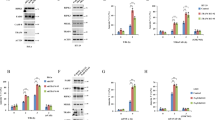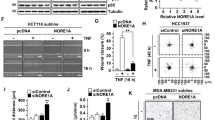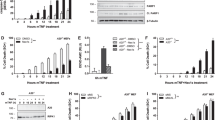Abstract
Thirty-eight-negative kinase 1 (TNK1) is a member of the ACK-family of nonreceptor tyrosine kinases and was originally cloned from CD34+/Lin-/CD38-hematopoietic stem/progenitor cells. The signaling pathways induced by TNK1 are largely unknown. Here, we report that expression and consequent activation of TNK1 enables tumor necrosis factor α (TNFα)-induced apoptosis by selectively inhibiting TNFα-induced activation of nuclear factor-κB (NF-κB). TNK1 has no effect on NF-κB DNA binding or the composition of the NF-κB complex; however, the kinase markedly prevents TNFα-induced NF-κB transactivation. TNK1 therefore acts as a novel molecular switch that can determine the properties of TNFα signaling and therefore cell death.
This is a preview of subscription content, access via your institution
Access options
Subscribe to this journal
Receive 50 print issues and online access
$259.00 per year
only $5.18 per issue
Buy this article
- Purchase on Springer Link
- Instant access to full article PDF
Prices may be subject to local taxes which are calculated during checkout





Similar content being viewed by others
References
Abu-Amer Y, Ross FP, McHugh KP, Livolsi A, Peyron JF, Teitelbaum SL . (1998). Tumor necrosis factor-alpha activation of nuclear transcription factor-kappaB in marrow macrophages is mediated by c-Src tyrosine phosphorylation of Ikappa Balpha. J Biol Chem 273: 29417–29423.
Beg AA, Baltimore D . (1996). An essential role for NF-kappa B in preventing TNF-alpha-induced cell death. Science 274: 782–784.
Boatright KM, Salvesen GS . (2003). Mechanisms of caspase activation. Curr Opin Cell Biol 15: 725–731.
Campbell KJ, Rocha S, Perkins ND . (2004). Active repression of antiapoptotic gene expression by RelA(p65) NF-kappa B. Mol Cell 13: 853–865.
Dougall WC, Glaccum M, Charrier K, Rohrbach K, Brasel K, De Smedt T et al. (1999). RANK is essential for osteoclast and lymph node development. Genes Dev 13: 2412–2424.
Eickhoff B, Germeroth L, Stahl C, Kohler G, Ruller S, Schlaak M et al. (2000). Trichostatin A-mediated regulation of gene expression and protein kinase activities: reprogramming tumor cells for ribotoxic stress-induced apoptosis. Biol Chem 381: 1127–1132.
Felschow DM, Civin CI, Hoehn GT . (2000). Characterization of the tyrosine kinase Tnk1 and its binding with phospholipase C-gamma1. Biochem Biophys Res Commun 273: 294–301.
Fuentes-Prior P, Salvesen GS . (2004). The protein structures that shape caspase activity, specificity, activation and inhibition. Biochem J 384: 201–232.
Green DR, Kroemer G . (2004). The pathophysiology of mitochondrial cell death. Science 305: 626–629.
Grumont RJ, Rourke IJ, Gerondakis S . (1999). Rel-dependent induction of A1 transcription is required to protect B cells from antigen receptor ligation-induced apoptosis. Genes Dev 13: 400–411.
Hayden MS, Ghosh S . (2004). Signaling to NF-kappaB. Genes Dev 18: 2195–2224.
Heyninck K, Beyaert R . (2005). A20 inhibits NF-kappaB activation by dual ubiquitin-editing functions. Trends Biochem Sci 30: 1–4.
Hoehn GT, Stokland T, Amin S, Ramirez M, Hawkins AL, Griffin CA et al. (1996). Tnk1: a novel intracellular tyrosine kinase gene isolated from human umbilical cord blood CD34+/Lin−/CD38− stem/progenitor cells. Oncogene 12: 903–913.
Imbert V, Rupec RA, Livolsi A, Pahl HL, Traenckner EB, Mueller-Dieckmann C et al. (1996). Tyrosine phosphorylation of I kappa B-alpha activates NF-kappa B without proteolytic degradation of I kappa B-alpha. Cell 86: 787–798.
Karin M, Ben-Neriah Y . (2000). Phosphorylation meets ubiquitination: the control of NF-[kappa]B activity. Annu Rev Immunol 18: 621–663.
Karin M, Lin A . (2002). NF-kappaB at the crossroads of life and death. Nat Immunol 3: 221–227.
Mukhopadhyay A, Shishodia S, Suttles J, Brittingham K, Lamothe B, Nimmanapalli R et al. (2002). Ectopic expression of protein-tyrosine kinase Bcr-Abl suppresses tumor necrosis factor (TNF)-induced NF-kappa B activation and IkappaBalpha phosphorylation. Relationship with down-regulation of TNF receptors. J Biol Chem 277: 30622–30628.
Navakauskiene R, Treigyte G, Gineitis A, Magnusson KE . (2004). Identification of apoptotic tyrosine-phosphorylated proteins after etoposide or retinoic acid treatment. Proteomics 4: 1029–1041.
Neumann B, Luz A, Pfeffer K, Holzmann B . (1996). Defective Peyer's patch organogenesis in mice lacking the 55-kD receptor for tumor necrosis factor. J Exp Med 184: 259–264.
Pasparakis M, Kousteni S, Peschon J, Kollias G . (2000). Tumor necrosis factor and the p55TNF receptor are required for optimal development of the marginal sinus and for migration of follicular dendritic cell precursors into splenic follicles. Cell Immunol 201: 33–41.
Schmitz ML, Baeuerle PA . (1991). The p65 subunit is responsible for the strong transcription activating potential of NF-kappa B. EMBO J 10: 3805–3817.
Schwenzer R, Siemienski K, Liptay S, Schubert G, Peters N, Scheurich P et al. (1999). The human tumor necrosis factor (TNF) receptor-associated factor 1 gene (TRAF1) is up-regulated by cytokines of the TNF ligand family and modulates TNF-induced activation of NF-kappaB and c-Jun N-terminal kinase. J Biol Chem 274: 19368–19374.
Taghiyev AF, Guseva NV, Sturm MT, Rokhlin OW, Cohen MB . (2005). Trichostatin A (TSA) sensitizes the human prostatic cancer cell line DU145 to death receptor ligands treatment. Cancer Biol Ther 4: 382–390.
Takada Y, Mukhopadhyay A, Kundu GC, Mahabeleshwar GH, Singh S, Aggarwal BB . (2003). Hydrogen peroxide activates NF-kappa B through tyrosine phosphorylation of I kappa B alpha and serine phosphorylation of p65: evidence for the involvement of I kappa B alpha kinase and Syk protein-tyrosine kinase. J Biol Chem 278: 24233–24241.
Tulasne D, Deheuninck J, Lourenco FC, Lamballe F, Ji Z, Leroy C et al. (2004). Proapoptotic function of the MET tyrosine kinase receptor through caspase cleavage. Mol Cell Biol 24: 10328–10339.
Vermeulen L, De Wilde G, Van Damme P, Vanden Berghe W, Haegeman G . (2003). Transcriptional activation of the NF-kappaB p65 subunit by mitogen- and stress-activated protein kinase-1 (MSK1). EMBO J 22: 1313–1324.
Wajant H, Pfizenmaier K, Scheurich P . (2003). Tumor necrosis factor signaling. Cell Death Differ 10: 45–65.
Zong WX, Edelstein LC, Chen C, Bash J, Gelinas C . (1999). The prosurvival Bcl-2 homolog Bfl-1/A1 is a direct transcriptional target of NF-kappaB that blocks TNFalpha-induced apoptosis. Genes Dev 13: 382–387.
Acknowledgements
Work in the lab of TS and SF is supported by the DFG (Clinical Research Group 167).
Author information
Authors and Affiliations
Corresponding author
Rights and permissions
About this article
Cite this article
Azoitei, N., Brey, A., Busch, T. et al. Thirty-eight-negative kinase 1 (TNK1) facilitates TNFα-induced apoptosis by blocking NF-κB activation. Oncogene 26, 6536–6545 (2007). https://doi.org/10.1038/sj.onc.1210476
Received:
Revised:
Accepted:
Published:
Issue Date:
DOI: https://doi.org/10.1038/sj.onc.1210476
Keywords
This article is cited by
-
Tyrosine kinase nonreceptor 1 (TNK1) knockdown ameliorates hemorrhage shock-induced kidney injury via inhibiting macrophage M1 polarization
3 Biotech (2021)
-
Polymorphism rs11867353 of Tyrosine Kinase Non-Receptor 1 (TNK1) Gene Is a Novel Genetic Marker for Alzheimer’s Disease
Molecular Neurobiology (2021)
-
TNK1 is a ubiquitin-binding and 14-3-3-regulated kinase that can be targeted to block tumor growth
Nature Communications (2021)
-
Role of Non Receptor Tyrosine Kinases in Hematological Malignances and its Targeting by Natural Products
Molecular Cancer (2018)
-
Role of CLU, PICALM, and TNK1 Genotypes in Aging With and Without Alzheimer’s Disease
Molecular Neurobiology (2017)



